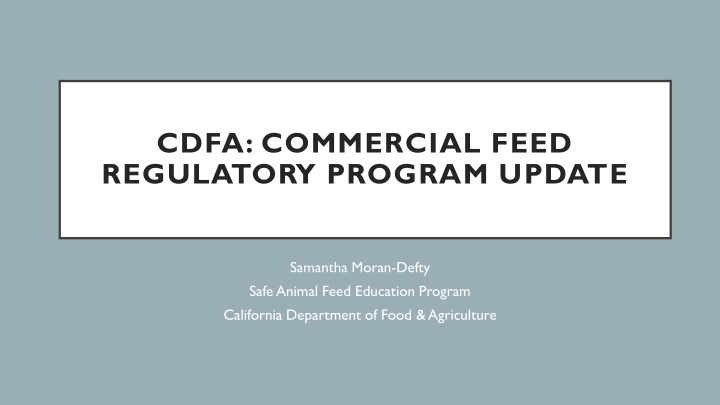



CDFA: COMMERCIAL FEED REGULATORY PROGRAM UPDATE Samantha Moran-Defty Safe Animal Feed Education Program California Department of Food & Agriculture
SAMPLE FOCUS Historical Sample Shift 1200 1000 54% 800 40% 39% 76% 600 400 46% 60% 61% 24% 200 0 2015 2016 2017 2018 Food Safety Label Compliance
MYCOTOXIN SCREEN • 107 samples in our Mycotoxin screen. • Samples were taken of at least 15 different states/countries of origin • 36 samples of Corn (15 organic, 21 conventional) • 12 samples of Cottonseed • 27 samples of Organic Canola • 12 samples of Rapeseed • Remaining are wheat, soy, alfalfa pellets
MYCOTOXIN SCREEN SUMMARY # of detectable levels # out of compliance H-T2 ppm (0) (0) Zearalenone (7) (0) Aflatoxin B-1 (33) (18) Aflatoxin B-2 (10) (8) Aflatoxin G-1 (26) (14) Aflatoxin G-2 (21) (14) Deoxynivalenol (20) (0) Fumonisin B-1 (21) (1) Orchratoxin (0) (0) T -2 Toxin (0) (0)
MYCOTOXIN LEVELS FOUND 200 180 160 140 120 100 80 60 40 20 0 Maximum levels found
ORGANIC VS CONVENTIONAL (FEED SAFETY AWARENESS) Increasing presence of aflatoxin in Organic commodities vs. Conventional. Consideration for Hazard Analysis Program has identified aflatoxin in organic commodities that have not historically been classified as having a high likelihood of mycotoxin presence.
GETTING READY FOR A FSMA INSPECTION
COMPLIANCE DATES
HOW TO PREPARE/ AREAS TO FOCUS Personnel Training (Personnel Hygiene and Qualified Individual Training) Maintaining Plant Cleanliness (clean up spills and clean out bins) Perform Food Safety testing (mycotoxins, heavy metals, etc.) Start your hazard analysis and complete your Food Safety Plan
HOW WE CAN HELP The SAFE program can come and perform CGMP Readiness Inspections The SAFE program can come and perform a Food Safety Plan review The program has a information and resources available on the SAFE website regarding Hazard Analysis, Preventive Controls, and CGMPs.
DIFFERENCE BETWEEN A STATE AND FEDERAL INSPECTION Commercial Feed Regulatory Program Inspection • Inspectors will be focused on looking at mills for compliance with state laws and regulations. • Inspectors will also use this opportunity to provide input and feedback to the mill to help the firm come into compliance with FSMA requirements Federal Contract Inspection • Perform the federal inspection per our contract. • We will be performing the inspection to FDA standards and collecting information on behalf of FDA
WHAT TO EXPECT FROM A FEDERAL INSPECTION Preventive Controls for Animal Food Inspection • Will include a CGMP Inspection and BSE if you handle prohibited mammalian proteins FSMA Current Good Manufacturing Practice Inspections • If assigned • Licensed and Non-Licensed Medicated Current Good Manufacturing Practice Inspections (will include VFD addendum if you use VFD medicated articles/feed) • BSE Inspections (performed if firm handles prohibited mammalian proteins)
WHAT TO EXPECT FROM A FEDERAL INSPECTION • During our contract inspections we will be asking for information on behalf of FDA • Import and export information • Corporate structure or company breakdown (i.e. Owner, Manager, Operations) • Hire & fire and repair authority • Plant design and layout (equipment type) • Production flow • Training • Product Traceability
WHAT TO EXPECT FROM A FEDERAL INSPECTION • These inspections may take anywhere from 1 day to 3 days (depending on the inspection type and the complexity of your firm and Food Safety Plan). • At the end of the inspection there will be a report that goes to FDA. Firms should receive a copy of the report within a few months. • You have the option to send FDA any corrections that you have made based on the Discussion Items that the inspector will talk about at the close out meeting. • We suggest sending this information to FDA and request an email to CDFA so that we can also document the corrections that you have made.
QUESTIONS Samantha Moran-Defty Safe Animal Feed Education Program Samantha.moran@cdfa.ca.gov (530) 632-4618
Recommend
More recommend